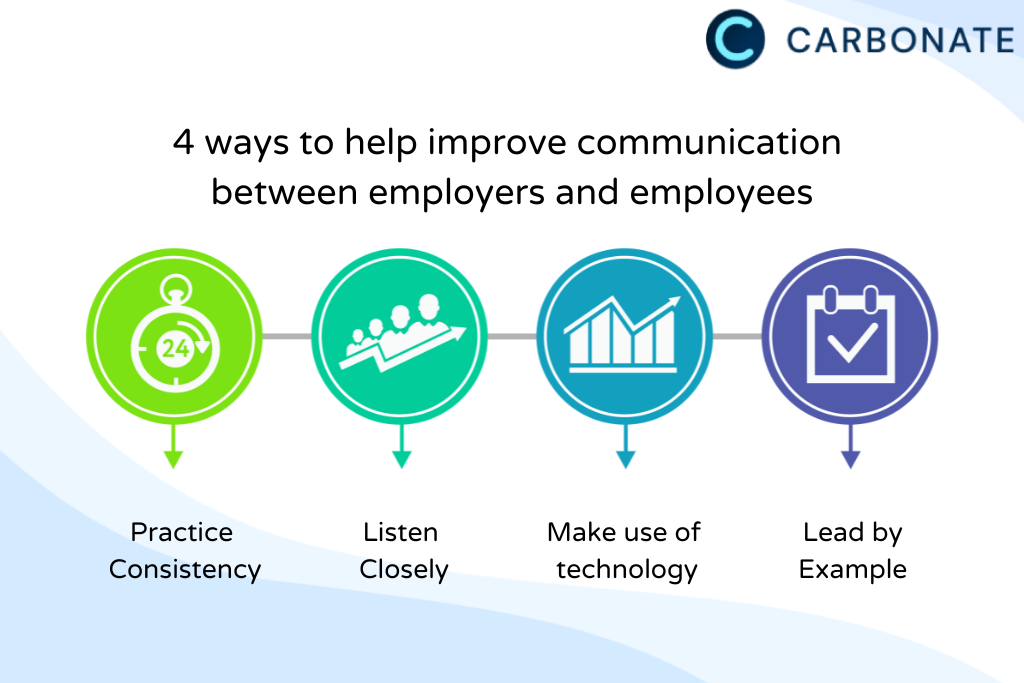4 ways to help improve communication between employers and employees

Business. You could call it human-oriented, filled with social interactions and relationships built around trust, reliability, and integrity.
With communication seemingly a top priority for many organizations, the question we should probably be asking ourselves is: how effective is internal communication between employees and their employers in most organizations?
Although it may be integral, communication seems to be often overlooked and typically difficult to manage. Businesses that can't practice effective communication in ways that resonate with their workforce might find themselves paying the price for it. This can come in the form of high turnover rates but, on the other hand, effective internal communication can help boost workforce morale/performance, increase productivity, and can ultimately lead to a flourishing company culture that supports and nurtures its people.
Effective internal communication can be a core part of making your HR leave management systems smoother/more relevant.
Here are a few things to look out for when trying to strengthen internal communications.

Practice Consistency
Probably one of the most essential rules of communication is that it remains open and consistent. This can help ensure that your people gradually feel more comfortable voicing their opinions or responding with questions. Managers need to find ways to communicate regularly without making the process tedious, especially if your workforce is made up of younger employees that have difficulty dealing with rigid routines. Hold regular staff meetings without making them weekly, for example. Have one-on-one meetings throughout the month and use social media platforms or email notifications as part of your communication arsenal.
It can be worth asking employees for their thoughts on different lines/modes of communication. Would they prefer getting updates via text messages on their smartphones? Would they like routine blasts of relevant company news (such as whenever there's a new client) or an infographic of quarterly sales figures? By organizing and issuing communication initiatives such as these, employees could feel more engaged with the company as a whole while, at the same time, understanding their roles and how they fit into the bigger picture/the organization's mission.
Listen Closely
Being a good listener maybe even more important than being a good speaker. Listening should be part of your communication process. Respect your employees’ opinions and when you’re setting aside some time to hear your team members out, don’t distract yourself with telephone calls or email notifications during conversations/discussions. Don’t interrupt your employee when they are speaking and keep your personal biases out of the way before you respond. These are elements of communication that can help encourage positive feedback and constructive criticism. In fact, the more your reputation as a good listener grows, the more comfortable employees could feel about communicating.
On the other hand, communication that’s one-sided or ineffective can lead to detrimental errors or serious misunderstandings. You might not be aware of the trouble brewing within the company until things get too far. By then, having a flurry of issues to deal with can be difficult and costly.
Make use of technology
You might find that internal communication strategies in the past were different from those used today and that previously, managers focused on employee magazines or content through an in-house intranet. These initiatives could have typically ended up draining resources without having much of a positive impact on productivity or the effectiveness of communication.
Nowadays, technology seems to have transformed nearly every aspect of how we handle business communications. Managers might want to consider investing in mobile app technology that can help organize and optimize internal communications strategies. In many instances, digital communication systems can provide a means of reaching out to employees, creating seamless operations and processes, and ultimately, helping companies thrive and manage their workforce in the best ways possible.
Lead by Example
Communication doesn’t necessarily refer to the usage of words to convey effective messages. Sometimes, employees may want to know that their managers are reliable and credible. By simply following through with what you say/practicing what you preach, you could be communicating an essential message in a very powerful way that establishes credibility.
Admit when you are wrong, make promises only when you know you can deliver and keep an open mind. You may just influence your employees to follow your lead. Give them credit for their contributions and make decisions that are fair and ethical. Don't mock their ideas (especially in front of others). It can also be very important that managers notice their communication style, non-verbal cues, and body language, adjusting themselves whenever necessary. Get this right and you could very well find that your employees are echoing in the footsteps of their leaders, promoting synergy and cooperation across the board.
A smarter HR system for a smarter business: Carbonate helps you keep track of attendance and leaves in your company, and keeps you connected to your staff with its built-in broadcasting and promotion messaging tool. Its employee profiles and HR leave management system meet MOM 2016 Employment Act Amendment requirements.
Click here to find out more.



